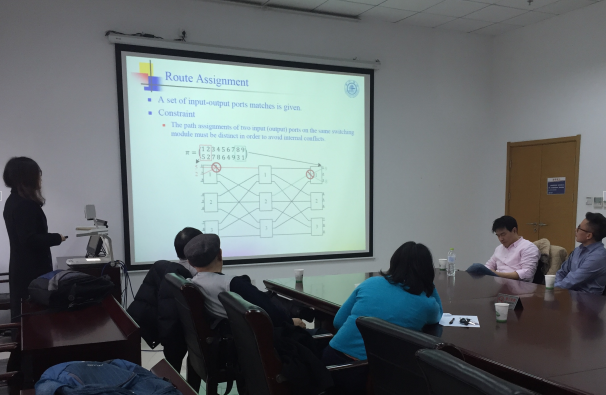 News
NewsAssoc. Prof. Tong Ye and Ph. D. student Lingkang Wang gave the following two talks:
Talk 1: Modular AWG-based Interconnection for Large-Scale Data Center Networks (by Tong Ye)
| Abstract: Along with the recent surge in scale expansion of data centers, the interconnection scheme is facing a grave challenge. A huge amount of cables between the switches make the system maintenance and heat dissipation extremely difficult. A promising solution to this problem is using the arrayed waveguide grating (AWG), which can provide a set of wavelength links between its inputs and outputs. However, the scalability of the AWG-based interconnection scheme is restricted by the coherent crosstalk and the wavelength granularity of AWGs. In this paper, we propose a generic modular AWG-based interconnection scheme with scalable wavelength granularity for mega data centers. We first devise a matrix-based method to decompose the AWG into a three-stage network of smaller AWGs, while preserving the nonblocking wavelength routing property of the AWGs. We then introduce the concept of wavelength independency based on the partitioning of the optical connections, such that modular AWGs in the network can reuse the same wavelength set with smaller granularity. We show that the proposed modular AWG-based interconnection network can simplify the cabling complexity of data center networks, while preserving the same function and bandwidth as the original data center network. |  |
Talk 2: Parallel Routing Algorithm based on Complex Coloring for Clos networks (by Lingkang Wang)
| Abstract: This paper explores the application of a new algebraic method of edge coloring, called complex coloring, to the scheduling problem of input-queued switches. The proposed distributed parallel scheduling algorithm possesses two important features: optimality and rearrangeability. Optimality ensures that the algorithm always returns a proper coloring with the minimum number of required colors, and rearrangeability allows partially re-coloring the existing connection patterns if the underlying graph only changes slightly. The amortized time complexity of the proposed parallel scheduling algorithm, in terms of the time to compute a matching in a timeslot, is on the order of O(logN), where N is the port count of switches. As for the scalability of input-queued switches, due to its low complexity, our algorithm can achieve nearly 100% throughput and provide acceptable queuing delay when the switch size N is large. Furthermore, the complex coloring method naturally provides an adaptive solution to non-uniform input traffic pattern. Thus, the proposed parallel scheduling algorithm is highly robust in the face of traffic fluctuations. |  |